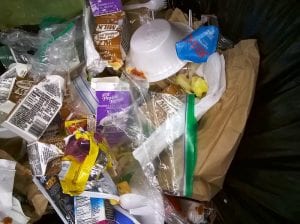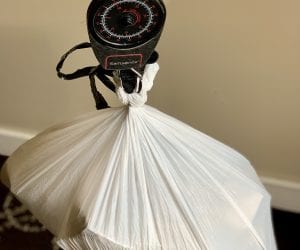Reducing waste in a K-12 school is no easy task. In a typical classroom, there’s lots of paper being used, lots of packaged lunches, and often, lots of wasted food. As part of PopEd’s focus on waste this month, I wanted to talk with an expert on how this challenge can be addressed – not only to reduce waste in schools, but also to boost students’ problem solving skills and to help them feel empowered to make positive changes in their school community.
Simon Warren, a former middle school teacher and now a student at Duke University’s Nicholas School of the Environment, used to be elbow deep in school waste. After his time as a classroom teacher, he worked for the EarthWays Center Division of the Missouri Botanical Garden and, through a grant from the Solid Waste Management District, spent much of his time helping teachers and schools reduce waste.
I had the pleasure of speaking with Simon last week to hear about his experiences with school waste reduction and learn some expert tips and tricks to help more teachers tackle this worthy challenge.
Inquiry-based Strategies for Reducing Waste at Your School
It should come as no surprise that Simon found the most successful strategy for waste reduction aligns with best practice teaching in general – keep it inquiry-based and student-led with measurable outcomes.
So how do you design an inquiry-based waste reduction project?
1. Understand the Issue
Simon mentioned the importance of first establishing background knowledge. Students need to understand the problem in order to feel motivated to solve it. One of the common ways he built interest and established base knowledge was to take a field trip to a landfill. If you’ve ever been to a landfill, you’ll understand why this is a powerful experience. Just seeing the scale of a landfill, with the heaps of trash, huge trucks, and of course, the smell, helps students visualize where trash ends up after it gets thrown away. And for older students, they’ll start to make important connections between landfills and methane production.
2. Research the Current Waste Situation
The next step was to conduct a waste-audit. In Simon’s experience, a waste audit entailed examining trash for about a week (a large tarp came in handy!) and then conducting some analysis to discover the types of trash being generated in the classroom or school. Was it mostly food waste? Classroom paper? Packaging materials?

3. Identify a Problem and Develop a Solution
Simon and his colleagues followed the engineering design process as a guide for helping students identify a specific waste issue to tackle, and most importantly, for developing a solution to combat it. The issues varied from school to school, ranging from food waste, to ziplock bags, to the all-in-one packaged utensils from the school cafeteria. Not surprisingly, the solutions were just as varied. Simon mentioned that many students involved the administration at their school in order to change policies and procedures, and often took advantage of resources in the community like commercial composting programs. The solutions worked – at the end of the year, students could see clear measurable reductions in the amount of trash headed for the landfill. Simon noted that students enjoyed having control over the process and especially liked making a tangible impact.

An example of a waste-reduction project that Simon helped facilitate at Sunrise R-IX Elementary while serving as a Green Mentor with the U.S. Green Building Council – Missouri Gateway Chapter’s Green Schools Quest.
Pitfalls and Tips when Reducing Waste at School
I asked Simon if he could share some tips, and pitfalls to avoid, for teachers who may want to reduce waste in their classroom or school.
If you’re a teacher who wants to reduce classroom waste but don’t know how to jump in, you can start by mulling over these waste-reduction tips from Simon:
- Tap into the huge amount of resources already available – you don’t need to recreate the wheel! Many landfills offer free guided field trips for school groups and in many places, state or county recycling and waste management companies will come to your school as guest speakers.
- Know that you’re likely not alone. If you speak-up as a champion for waste-reduction efforts, you will often find that others in your school feel the same way.
- Don’t be squeamish about composting!
- Remember that trash is a good place to build in inquiry and allow kids to lead. Everyone has first-hand experience with it, it brings in science, math and social studies and it is a really great way to put power in kids’ hands.
As for pitfalls, Simon mentioned that students were often already familiar with the concepts of reducing, reusing, and recycling but usually their knowledge ended there. Before his arrival, there was little discussion in their classroom or community about how or why trash was created in the first place and the importance of minimization on the front-end. There was also limited knowledge of the waste management system as a whole and how it is related to broader issues like climate change and social justice. Simon expressed the importance of filling in these gaps – making sure students step back to get a holistic view, and ensuring they feel connected to the issue in a way that matters to them, whether through the lens of climate change, animal welfare, or environmental justice.
Thanks again to Simon for sharing his experience and wisdom!
The EarthWays Center continues to be active in reducing school waste in the St. Louis area as well as supporting as Green Mentors for the Green Schools Quest through the U.S. Green Building Council – Missouri Gateway Chapter. For more information on programming, please visit the links above.
Image credits: “waste 2016 mar 7 cafeteria-elementary school” by G Witteveen is licensed under CC BY-NC 2.0; ‘Milk Cartons’ waste reduction project (2016-2017 Green Schools Quest Submissions (page 2))



